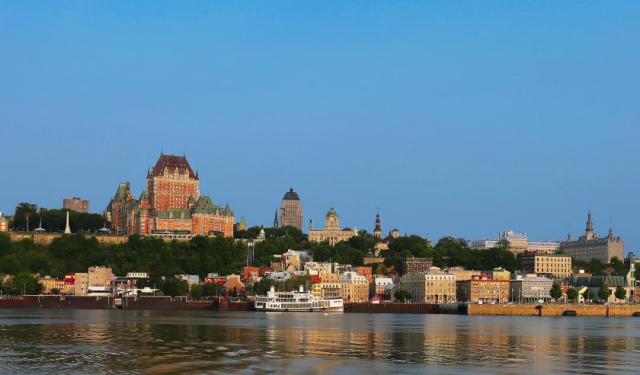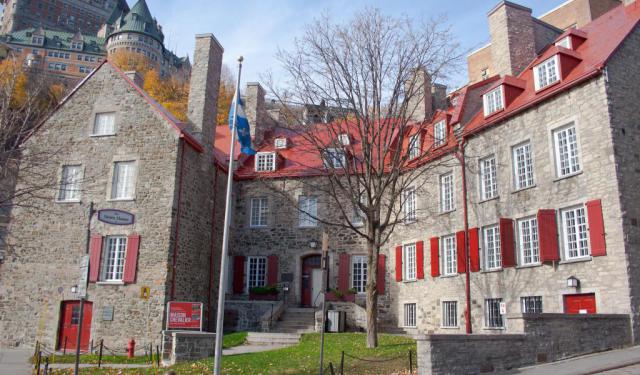
Jesuit Chapel (Chapelle des Jesuites), Quebec City
The Jesuit Chapel is located on the former grounds of the Jesuit college in Old Quebec. It was constructed between 1818 and 1820, following the design by architect François Baillairgé.
Initially, the chapel was administered by priests from the Notre Dame Basilica-Cathedral, whose congregation took over the management of the Jesuit College after the Jesuit order was expelled from Quebec in 1773. In 1842, the Jesuits were permitted to return, and in 1856, they established a residence nearby. A year later, the chapel underwent expansion, including the addition of new windows on both sides, but it wasn't officially transferred to the Jesuits until 1907.
In 1930, architects Ludger Robitaille and Gabriel Desmeules redesigned the building's façade and altered the shape of its roof. In 1949, changes were made to the chancel, which included the removal of the nave galleries, and the chapel was dedicated to the Canadian Martyrs, with statues and relics of these martyrs housed inside.
The interior of the chapel has seen a series of modifications over the years, starting with the construction of the faux vaulting. Its focal point is the main altar, crafted by Eugène Taché in 1888, accompanied by several stained glass windows designed by Bernard Leonard in 1916.
Currently, the building serves as a charitable organization on the ground floor, situated beneath the chapel. This organization is dedicated to improving the living conditions of migrants arriving in Quebec.
Initially, the chapel was administered by priests from the Notre Dame Basilica-Cathedral, whose congregation took over the management of the Jesuit College after the Jesuit order was expelled from Quebec in 1773. In 1842, the Jesuits were permitted to return, and in 1856, they established a residence nearby. A year later, the chapel underwent expansion, including the addition of new windows on both sides, but it wasn't officially transferred to the Jesuits until 1907.
In 1930, architects Ludger Robitaille and Gabriel Desmeules redesigned the building's façade and altered the shape of its roof. In 1949, changes were made to the chancel, which included the removal of the nave galleries, and the chapel was dedicated to the Canadian Martyrs, with statues and relics of these martyrs housed inside.
The interior of the chapel has seen a series of modifications over the years, starting with the construction of the faux vaulting. Its focal point is the main altar, crafted by Eugène Taché in 1888, accompanied by several stained glass windows designed by Bernard Leonard in 1916.
Currently, the building serves as a charitable organization on the ground floor, situated beneath the chapel. This organization is dedicated to improving the living conditions of migrants arriving in Quebec.
Want to visit this sight? Check out these Self-Guided Walking Tours in Quebec City. Alternatively, you can download the mobile app "GPSmyCity: Walks in 1K+ Cities" from Apple App Store or Google Play Store. The app turns your mobile device to a personal tour guide and it works offline, so no data plan is needed when traveling abroad.
Jesuit Chapel (Chapelle des Jesuites) on Map
Sight Name: Jesuit Chapel (Chapelle des Jesuites)
Sight Location: Quebec City, Canada (See walking tours in Quebec City)
Sight Type: Religious
Guide(s) Containing This Sight:
Sight Location: Quebec City, Canada (See walking tours in Quebec City)
Sight Type: Religious
Guide(s) Containing This Sight:
Walking Tours in Quebec City, Quebec
Create Your Own Walk in Quebec City
Creating your own self-guided walk in Quebec City is easy and fun. Choose the city attractions that you want to see and a walk route map will be created just for you. You can even set your hotel as the start point of the walk.
Qucbec City's Historical Churches Walking Tour
The first religious buildings in Canada were established by the Récollets and Jesuits, in 1615 and 1625, respectively, when they first arrived in New France. Later on, the French colonists brought along their culture and architectural traditions, and the establishment of British and evangelical society triggered further major developments in Quebec City.
Over the course of the 17th and 18th... view more
Tour Duration: 2 Hour(s)
Travel Distance: 2.9 Km or 1.8 Miles
Over the course of the 17th and 18th... view more
Tour Duration: 2 Hour(s)
Travel Distance: 2.9 Km or 1.8 Miles
Old Quebec Walk
The historic part of Quebec City known as Old Quebec (French: Vieux-Québec), sometimes also referred to as the Latin Quarter (Quartier Latin), is the neighborhood centered around Cape Diamond (Cap Diamant), located on the eastern edge of Quebec hill promontory. The area comprises Upper Town (Haute-Ville) and Lower Town (Basse-Ville) and is currently listed among UNESCO’s World Heritage Sites.
... view more
Tour Duration: 2 Hour(s)
Travel Distance: 2.6 Km or 1.6 Miles
... view more
Tour Duration: 2 Hour(s)
Travel Distance: 2.6 Km or 1.6 Miles
Quebec City Introduction Walking Tour
Cresting a cliff above the St. Lawrence River, Québec City (French: Ville de Québec) is the soul of the province of Québec – a place all its own; a country within a country with its own traditions, architecture, and French-speaking population.
The Algonquian people had originally named the area Kébec, which means "where the river narrows", because the Saint Lawrence River... view more
Tour Duration: 2 Hour(s)
Travel Distance: 3.2 Km or 2 Miles
The Algonquian people had originally named the area Kébec, which means "where the river narrows", because the Saint Lawrence River... view more
Tour Duration: 2 Hour(s)
Travel Distance: 3.2 Km or 2 Miles
Historical Houses Walking Tour
Quebec City, particularly evocative of Europe in its atmosphere, is often referred to as the cradle of New France. The city boasts one of the richest architectural heritages in North America, though most of its buildings had to be adapted to harsh winters and the lack of specialized workers and materials in the colony. As such, the majority of local houses were designed as simple and efficient... view more
Tour Duration: 2 Hour(s)
Travel Distance: 2.5 Km or 1.6 Miles
Tour Duration: 2 Hour(s)
Travel Distance: 2.5 Km or 1.6 Miles




